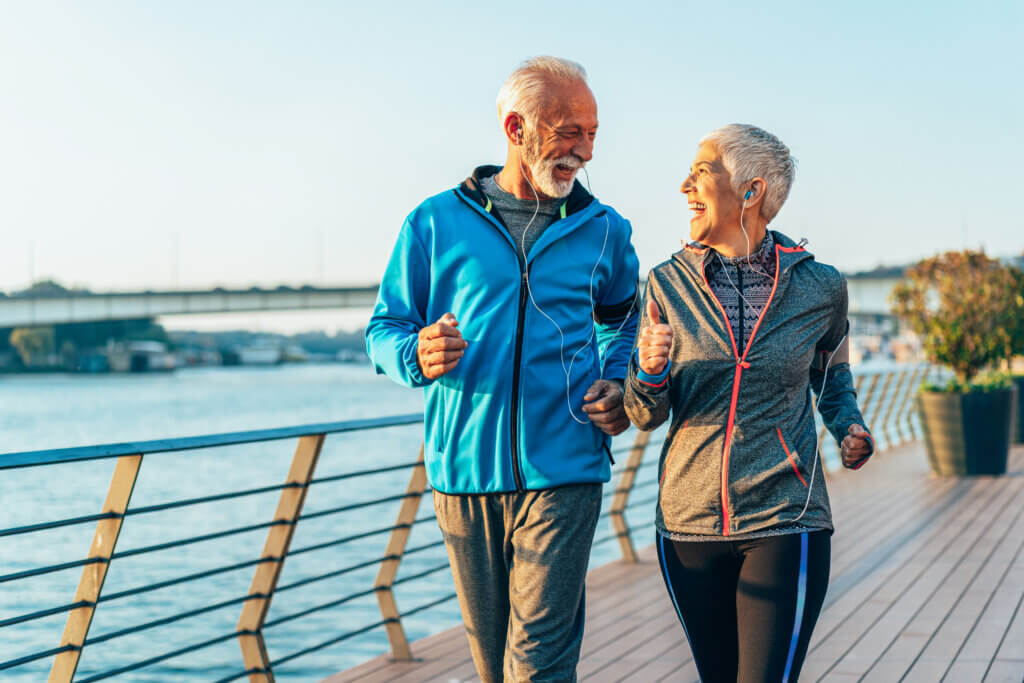- Exercise is being researched as a potential supportive treatment for cancer patients, with trials exploring its ability to alleviate side effects and improve treatment outcomes.
- Specialized exercise interventions are being developed for marginalized groups to address systemic barriers and improve health outcomes, with ongoing trials focusing on the unique needs of these populations.
- The long-term vision includes integrating exercise into the clinical care experience of cancer patients, with both in-person and virtual options being explored to ensure high adherence and enhance the treatment journey.
To help reduce the risk of cancer, the American Cancer Society recommends at least 150 minutes a week of exercise or activity — a 30 minute walk each weekday, for instance — plus some strength training twice a week for good physical health.
But researchers at Dana-Farber and other cancer centers are exploring the possibility that exercise could be specifically prescribed as medicine for cancer patients. Christina Dieli-Conwright, PhD, MPH, an exercise oncologist who runs the inaugural exercise oncology research laboratory at Dana-Farber, is investigating several exercise interventions that could help reduce side effects and improve outcomes for patients.
“There’s a lot of excitement right now around the question of whether exercise can actually alter treatment-related endpoints,” says Dieli-Conwright. “Are those who exercise more likely to respond better to treatment?”
Exercise as supportive medicine

Much of the research around exercise and cancer has focused on patients who have completed therapy. Dieli-Conwright wants to intervene during treatment, while patients are taking medicines that might have difficult side effects.
She is running several clinical trials to determine whether exercise could be a form of supportive care that alleviates symptoms and increases the chances that a patient might complete therapy. For instance:
- The RE-BUILD Trial is investigating the feasibility of virtually supervised resistance exercise combined with protein supplementation to patients with pancreatic cancer who are receiving chemotherapy and may experience loss of skeletal muscle mass during treatment.
- The CLARITY Trial is investigating the effects of high-intensity interval training (HIIT) for patients with early-stage breast cancer who are receiving chemotherapy to determine if the exercise intervention has an influence on cognitive function.
- The MOBILITY Trial is investigating strength and aerobic training for patients with ovarian or endometrial cancer who are receiving chemotherapy to see if the exercise influences mobility or neuropathy, a form of nerve damage that can affect feeling in the feet and hands.
Exercise interventions designed for marginalized groups
Dieli-Conwright recognizes that patients from groups that have been historically marginalized in medicine can have reduced fitness levels, higher rates of obesity and heart disease, and higher risks of poor outcomes. Systemic marginalization results in lower levels of income, fewer resources for support and family care, and less access to medical care and wellness programs. All these factors together increase the chances that people from these groups will face health challenges.
“We would be remiss to not focus on interventions that can specifically help people from groups that have been underrepresented in clinical trials,” she says.
She currently has several clinical trials that include the involvement of family members, support groups with people from similar groups or backgrounds, transportation assistance, and more.
These trials include:
- The ROSA Trial offers virtually supervised exercise programs that focus on improving metabolic health for obese early-stage Latina breast cancer survivors.
- The THRIVE Trial offers a 16-week exercise intervention designed to increase physical activity among Black and Hispanic breast, colorectal, or prostate cancer patients receiving chemotherapy.
- The POWER Trial is focused on exercise and its ability to reduce cardiovascular disease risk factors in Black prostate cancer patients taking androgen deprivation therapy.
Training for treatment

The same way an athlete can prepare for a sporting event, patients can prepare for cancer treatment. Dieli-Conwright is interested in learning more about whether pre-habilitation exercise training helps patients prepare for and endure treatment.
For example, the PROTECT Trial is examining the effects of an aerobic and resistance training program in patients with multiple myeloma who are scheduled to receive an autologous stem cell transplant.
Learn more about the trials in Dieli-Conwright’s exercise oncology lab at Dana-Farber.
To find a specific trial, visit Dana-Farber’s Clinical Trials page and search for “exercise.”
Long-term vision
Imagine infusion facilities, waiting rooms, and hospital wards that also have seamlessly integrated spaces for exercise. This is Dieli-Conwright’s vision of a world where exercise and movement are integral to the experience of clinical care.
Yet Dieli-Conwright knows that not everyone is comfortable with exercising with others. While some of her trials offer in-person, in-clinic exercise interventions, others are offered virtually. She has evidence suggesting that adherence to the interventions is about the same either way, at a minimum of 80%.
“Once people join an exercise trial, they participate,” she says. “People generally enjoy the physical benefits and having something positive they can do for themselves during treatment.”
About the Medical Reviewer

Dr. Dieli-Conwright received her BS in Biological Sciences from California Polytechnic State University San Luis Obispo and her MS in Kinesiology from California State University Northridge. She earned a MPH, and PhD in Biokinesiology from the University of Southern California. Following a postdoctoral fellowship in Cancer Etiology at the City of Hope National Medical Center, she was the Director of the Integrative Center for Oncology Research in Exercise and Assistant Professor of Biokinesiology and Medicine at the University of Southern California. In 2020, she joined the faculty of the Dana-Farber Cancer Institute and Harvard Medical School.

Very promising set up
I personally doubled my exercise from 45 to 90 min per day including day 1 post surgery and during chemo. It was phenomenal for my head and body.
Exercise is medicine.
Exercise is definitely a factor in recovery from any invasion of the systems of the body. Not only does it keep the blood flowing through your muscles, but involves good endorphins that take away depression.
I am a Bone Building instructor and know how important it is to keep moving.
This is really thrilling! There is so much research out there about exercise being helpful for cancer treatment, much of it focused on aerobic exercise since cancer likes an anaerobic environment to grow.
When I was recently inpatient for a week at a Dana Farber unit at Brigham, starting a new immunotherapy, I asked the staff if there were a gym patients could use to stay healthy. They did have an exercise bike they could pull in from another unit, but wouldn’t it be great to have a treadmill, elliptical machine and maybe some free weights available also for Dana Farber hospital patients, as well as in our outpatient system? Less time sitting in the waiting room, more time on the treadmill, translates to better health and habits!
Thank you for doing this fabulous work!
As a cancer patient I find exercise not only keeps me moving but helps me mentally. My preferred exercise is walking ( I incorporate incline as well) outdoors. Observing nature ( even in nasty weather!) is a boost and carries over to the rest of my day. I like to change my walks up to the beach, botanical gardens etc. I am fortunate to have a great walking partner- my husband!
Love love this connection.
I have kept up with swimming through surgeries, chemotherapy, and radiation. It has been great to feel energized, upbeat, and normal. For me, swimming is always something to look forward to, an anticipated joy. For now, the cancer has disappeared.
I am 37 and very active. In March 2023 I was diagnosed with classic hodgkin lymphoma stage IV. I was treated March-Aug. With 12 AAVD treatments. Throughout treatment I exercised at a very hard level focusing on cardio through riding my road and mountain bikes and strength training. In October i relapsed and underwent additional treatment of Pembro + GVD followed by an Autologous stem cell transplant in January. Again pre transplant and almost immediately after i started working out. I feel i had minimal side effects and currently feel back to pretty much normal energy, health and strength. I feel exercise through both treatments helped tremendously with side effects and fatigue as well as my mental health. I think promoting exercise for patients will be extremely beneficial. It does not have to be strenuous just enough to keep moving!